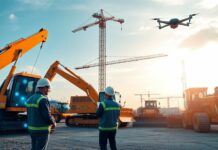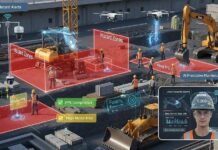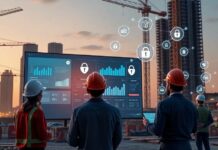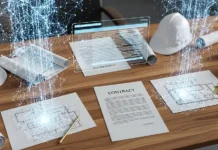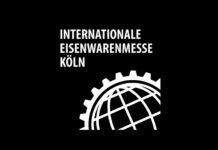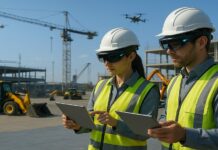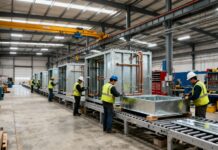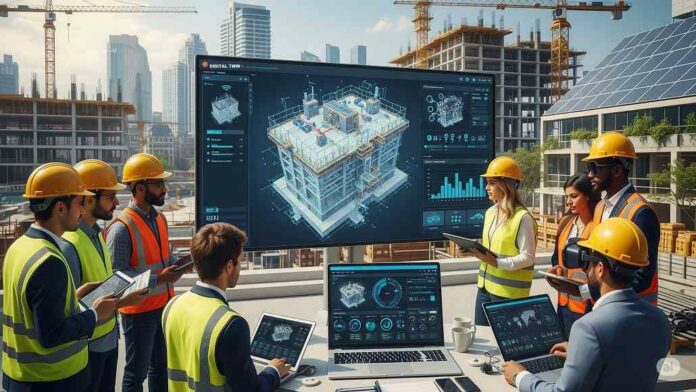In recent years, the construction sector has gone on to witness a technological renaissance, which is driven by the advent of Digital Twins and building information modeling (BIM). Both of these tools have gone on to transform individually how professionals design, construct, and even function the infrastructure. But their true potential happens to emerge when their pathways intersect, thereby creating a synergy that enhances the overall life-cycle management of built-in environments. As the industry transitions towards a more sustainable, smarter, and resilient infrastructure, understanding the points of convergence between BIM and Digital Twins is indeed necessary for stakeholders who are looking forward to leading this transition.
The base of Digital Twins and BIM in construction
It is well to be noted that building information modeling has long established itself as the imperative of digital transformation in construction. It happens to involve creating comprehensive digital representations pertaining to physical assets – infrastructure, architecture, and equipment—which help facilitate precise planning, cost estimation, clash detection, and project management. The emphasis of BIM on partnership as well as data sharing has prominently decreased the rework, error, and also delays throughout the project phases.
If you talk of Digital Twins, they extend the concept of digital representation within the operational phase. They are dynamic as well as real-time models that mirror the physical asset all across its life cycle. Powered by AI, IoT sensors, and data analytics, Digital Twins help with predictive maintenance, scenario testing, and even performance optimization. While the BIM traditionally focused on designs as well as construction, Digital Twins, on the other hand, encompass functional management by creating a very easy digital spectrum, right from start to decommissioning.
It is worth noting that both the tools are inherently data-driven. Their convergence happens to hinge on shared data standards, integrated workflow, and technological interoperability, which at the end of the day forges a robust digital ecosystem within the environment.
The points of convergence – Integration synergistically
The convergence when it comes to Digital Twins as well as BIM happens to be rooted in their shared foundation pertaining to data-rich models as well as the overarching objectives of life-cycle management. At their intersection happens to lie a comprehensive framework, which spans construction, design, operation, and maintenance by delivering unprecedented insights along with control.
One of the major points of convergence happens to be the realm of asset management. BIM models throughout the design as well as construction phases happen to serve as a detailed repository of special, geometric, and material data. When elevated with IOT sensor data throughout the operational phase, these models go on to evolve into Digital Twins, which consistently update as well as reflect conditions in real time. This kind of integration enables the facility manager to track environmental conditions, structural health, and even energy performance by helping with proactive maintenance along with optimized operations.
Another prominent intersection happens to reside in scenario evaluation, as well as simulation. The detailed models of BIM offer a backbone for virtual simulation when it comes to construction sequencing, estimations in cost, and/or detection. When linked along with digital twin technology, these simulations can extend into real-time operational scenarios, which include energy management, response planning, and even life-cycle performance forecasting.
Advantages of integrating Digital Twins along with BIM
The integration of Digital Twins as well as building information modeling goes on to offer transformative benefits that go beyond the entire life cycle of infrastructure projects. This kind of convergence not just refines the construction and planning phases but also revolutionizes the functional management, maintenance, and, at the end of the day, decommissioning. The core advantages are elevated predictive capabilities, operational effectiveness, sustainability, safety, and partnership by way of comprehensive subpoints that detail how these benefits manifested and why they are so crucial when it comes to future infrastructure.
Elevated predictive maintenance along with asset longevity
One of the most prominent advantages of merging Digital Twins along with BIM happens to be the profound enhancement within predictive maintenance capacities. BIM models during the design as well as construction process happen to contain detailed information when it comes to structural elements, materials, and even component specifications. When these models get linked with real-time data streams coming from IoT sensors that are embedded within the physical assets, they evolve into dynamic Digital Twins, which are capable of consistently tracking the health of the asset.
It is well to be noted that the consistent data flow enables the facility manager to predict potential failures before they even take place. For example, IoT sensors can track temperature fluctuations, stress loads, or vibrations on critical structural components. When these data points go on to deviate from the norm, the digital twin signals the need for a certain amount of maintenance, often before any kind of visible damage takes place. This kind of predictive approach reduces unplanned downtime, decreases any sort of repair costs, and even extends the lifespan of the assets within the infrastructure, therefore delivering substantial long-term savings along with functional resilience.
Besides, this kind of integration facilitates a transition from reactive to proactive maintenance regimes. Maintenance activities happen to become scheduled tasks that are based on real-time evaluation rather than fixed timeframes, hence optimizing the resource allocation and at the same time decreasing interventions that are unnecessary.
Driving the sustainability and decreasing the environmental impact
It is well to be noted that sustainability happens to remain a central concern when it comes to the construction industry. Specifically, as global climate commitments become stricter and environmental regulations get more rigorous. The convergence of Digital Twins along with BIM prominently contributes towards sustainability objectives by helping with more precise and data-driven decisions with regard to energy efficiency along with resource usage.
BIM models, which initially are capable of simulating energy consumption along with environmental effects during the design phase, are elevated by way of integration along with real-time and functional data from Digital Twins. Facilities managers can consistently track energy consumption, indoor environmental quality, water usage, and even carbon emissions by way of live dashboards, empowering the organizations to execute targeted interventions that go on to deplete the environmental footprints.
By way of evaluating the operational data, stakeholders can go on to identify inefficiencies like HVAC systems running behind the required levels or lighting more occupancy requirements. Alterations that are based on these insights lead to optimized energy usage, decrease greenhouse gas emissions, and also better resource management. Moreover, the ability to simulate future scenarios, like the impact of adding renewable energy sources, helps in going ahead and planning the infrastructure upgrades, which are in sync with sustainability objectives.
Majorly improved operational efficiency along with cost savings
It is well to be noted that operational efficiency happens to be a very vital metric for infrastructural stability, budget adherence, and the project’s overall success. While the detailed design data from the BIM is combined with the real-time insights coming from Digital Twins, organizations unleash new levels of functional agility. Facilities managers can make the utmost use of live dashboards along with analytics in order to come up with data-driven decisions fast. For instance, they can track the performance of HVAC, safety systems, and lighting in order to identify anomalies and schedule maintenance performance before the systems fail or become inefficient. This kind of real-time oversight reduces functional disruption, elevates occupants comfort, and, of course, decreases energy wastage. Besides this, predictive analytics, which are derived from Digital Twins, help with optimal resource utilization.
Enhanced safety and risk management
Safety happens to be paramount in the construction sector, where hazards are pretty high during both construction as well as operational phases. The integration of Digital Twins along with BIM goes on to offer a new paradigm when it comes to safety management by way of comprehensive risk evaluation, real-time tracking, and even simulation. During the construction phase, BIM models offer detailed visualization along with clash detection by minimizing the hazards that are related to design conflicts or even spatial arrangements. When connected with Digital Twins, these models go on to evolve into live representations, which incorporate the sensor data based on structural integrity, equipment status, and environmental conditions. It is worth noting that the real-time data feeds enable the safety teams to track critical parameters such as structural stability, environmental conditions like wind speed or temperature, and hazardous material levels. If sensors detect certain unsafe conditions like structural stress exceeding a safe threshold or gas leaks, which are really hazardous, the Digital Twins can trigger alerts by prompting immediate action that needs to be taken.
Fostering partnerships along with data transparency throughout the stakeholder Spectrum
Effective partnership among diverse stakeholders, right from architects and engineers to maintenance teams, as well as facility managers, is essential for successful project delivery and also asset management. The integration of BIM and Digital Twins happens to create a shared digital platform, which gives out communication, transparency, and data continuity. With BIM models serving as the base design and construction data repository and Digital Twins offering live updates during operations, all stakeholders get to access a unified, evolving data environment. This kind of transparency decreases the risk of miscommunication, speeds up the decision-making process, and also streamlines the workflows.
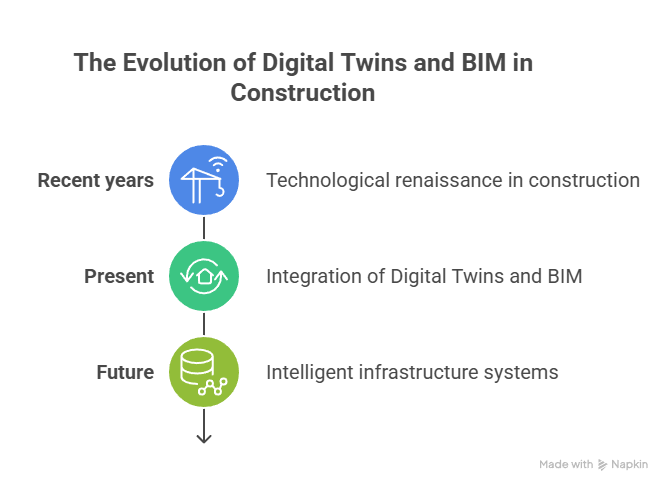
What are the future trends and industry outlook?
It is worth noting that the future of the built environment is going to be shaped by the seamless integration of Digital Twins along with BIM, thereby fostering a complete intelligent infrastructure spectrum. As IoT devices become more affordable and also ubiquitous, the volume along with the quality of real-time data feeding into Digital Twins is going to exponentially rise by helping hyper-accurate models that adapt instantaneously towards operational changes. The development as well as adoption of open standards along with interoperability protocols is going to play a very crucial role by making sure that different systems, regardless of their vendors or platforms, can go ahead and communicate in a very simple way. Industry, consortiums, and regulatory bodies are increasingly advocating for such kinds of standards in order to help with widespread adoption and also data sharing. Artificial intelligence as well as machine learning algorithms will further elevate the predictive analytics by offering smarter insights into asset performance, lifestyle costs, and the effects on the environment. These advancements are going to lead to smarter cities wherein the infrastructure goes on to adapt dynamically to the usage patterns, environmental conditions, and even safety requirements. The integration of Digital Twins with BIM is also anticipated to revolutionize the project delivery models, transitioning from traditional linear processes to more data-driven and iterative workflows. This kind of transition is going to decrease project duration, cut expenditures, and also enhance the quality—all the benefits that stakeholders across the industry are looking forward to realizing.
In the end
The convergence of Digital Twins and building information modeling happens to be a paradigm transition in the management of the built environment. By way of making utmost use of the strengths of both technologies, which are BIM’s detailed design and planning capabilities combined with the real-time operational insights from the Digital Twins, the sector is indeed moving towards future infrastructure that is much more sustainable, much smarter, and much more resilient. The integration goes on to offer tangible advantages in predictive maintenance, safety, energy efficiency, and also stakeholder partnerships, thereby transforming how assets are built, conceived, functioned, and even decommissioned. As technological innovations continue to go on and standards keep maturing, the synergy between BIM and Digital Twins is going to become the backbone of intelligent infrastructure systems, thereby delivering value throughout the entire life cycle. Industry stakeholders have to embrace this kind of convergence in a much more proactive way through investing in interoperable platforms and cultivating a mindset that is sort of inclined towards a digital-first scenario. The spectrum of built environment management happens to be on the cusp of a new era, one that is defined by data-driven decision-making, sustainability, and resilience. The future is indeed digital, and the convergence of Digital Twins and BIM in construction is, of course, leading the way.








